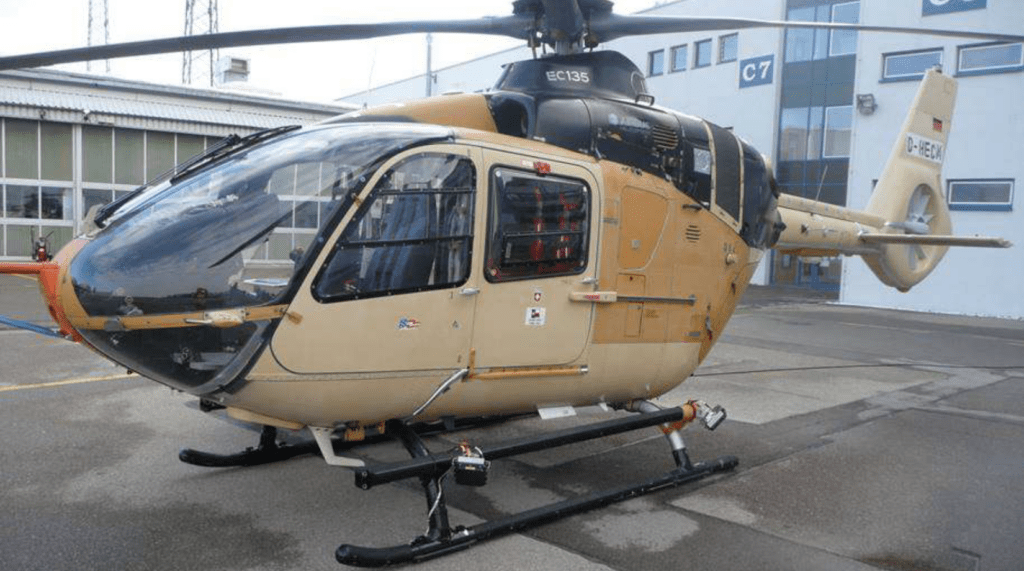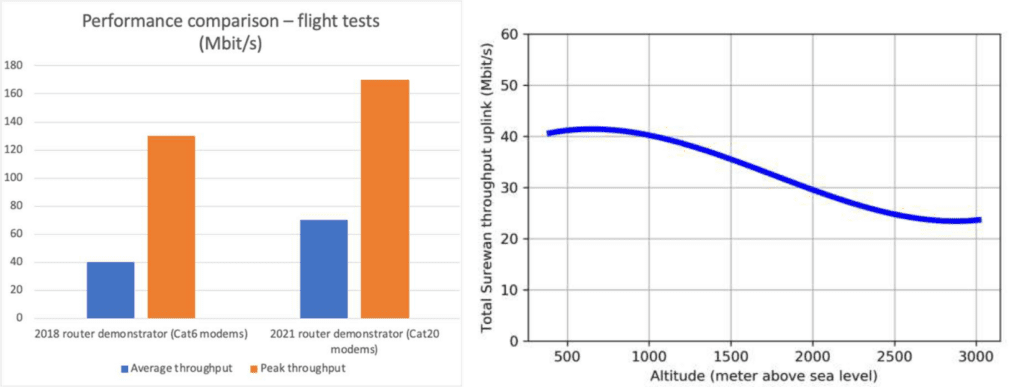An Icomera research team designed, deployed, and tested a system that provides reliable, fast, and cost-effective broadband connectivity to helicopters and drones flying up to 10,000 ft above ground, using only existing LTE and 5G cellular radio technology infrastructure. The system test was conducted in collaboration with Airbus and VITES GmbH as part of the Federal Aviation Research Programme (“LuFo”) Air-to-Ground (A2G) communications trial supported by the German Federal Ministry for Economic Affairs and Climate Action.
The Limitations of In-Flight Communications Technologies
Currently, there are no reliable means of providing Internet connectivity to rotary-wing aircraft in flight, which presents a significant limiting factor in the communications capabilities and digital services that can be provided to airborne helicopters. These considerations are particularly important for emergency services such as ‘Air Ambulances’, police air support units, and search and rescue operations.
As is the case with other communications, the higher the capacity of available radio links, the more services can be provided for vehicles, staff, and passengers, for example real-time video surveillance, video analytics, condition monitoring, and data-intensive passenger applications such as video conference calling and streaming entertainment.
Current proposals for improving Air-to-Ground (A2G) communications include deploying and operating dedicated and fully redundant 5G networks solely for this purpose, however these plans do come with significant limitations and a hefty price tag attached. Firstly, the proposed radio frequency bands for the dedicated A2G networks will be limited in their bandwidth, meaning that they can only provide a fraction of the data capacity of commercial networks, restricting their comparative efficacy for a wide range of applications.
Secondly, the huge financial investment required for establishing and maintaining these networks, which require a much larger cell radius than commercial networks, becomes a prohibitive factor.
It therefore makes sense for aviation authorities to explore more cost-effective methods, such as leveraging existing commercial infrastructure to maintain a safe and secure network for A2G communications, which can already provide abundant levels of data capacity while considerably reducing installation, maintenance, and data costs.
Investigating the Possibilities
Sensing an opportunity to solve problems through innovation, Icomera brought its expertise in providing connected solutions for public transport to the LuFo programme to test whether its core technology could be combined with sectorised antennas to provide a more reliable and cost-effective solution for A2G communications and learn lessons that could be applied to ground-based public transport connectivity.

The Eurocopter H135 no.886 helicopter
The Test Flights
Icomera developed the communication system using two of its high-performance X-Series Multi-Radio Mobile Access & Applications Routers to aggregate all available connectivity to the Airbus H135 Helicopter’s externally mounted sectorised antennas (antennas which can be slotted together to provide omnidirectional coverage).
In addition, Icomera developed software specifically designed to visualise and monitor the test flights, while the observer simultaneously receives information on all relevant communication parameters, as well as helicopter parameters such as speed, altitude, and course.
Over two trials taking place in 2018 (using only 4G LTE connectivity) and 2021 (LTE and 5G), the helicopter was seamlessly connected to a multitude of terrestrial base stations belonging to multiple operators as it traversed the skies over the German state of Bavaria.
Custom-developed software shows the helicopter aggregating links as it moves along its route
The Results
While travelling along the route, the connectivity system adapted using dynamic “self-adjustment” to the constantly changing conditions of the radio channel. An in-depth analysis of the flights showed that each individual sector achieved 91-97% connectivity over time, but by aggregating all modems/sectors using Icomera’s SureWAN™ protocol, the router on board the helicopter was reliably connected throughout 100% of the flight time.
The reliability of the connectivity was not the only staggering result of the trial. The uplink throughput provided during the trial was particularly notable, given its importance for mission-critical applications such as communications during search and rescue operations. While the test flights in 2018 saw an average throughput of approximately 40 Mbit/s using only LTE technology, the flights in 2021 saw an average of 60 Mbit/s using 5G, with a peak throughput of up to 176 Mbit/s.

Graphs showing the performance of the onboard connectivity during the trials
The Future of Avionic Communications and the Implications for Land-based Transport
Because of the high reliability and continuity achieved, Icomera’s system enables both critical (e.g. remote control) as well as non-critical (e.g. video and Internet access) communication services at a much lower cost compared to building dedicated terrestrial networks for avionics communications.
By participating in the LuFo project, the Icomera team were able to solve significant problems unique to the aviation industry which, in turn, allowed for the development of its connectivity strategy for land-based public transport networks using a ‘lessons learned’ approach.
The methods and technologies used to provide A2G communications in the study are now being applied to Icomera’s connectivity solution for rail networks, which already rely on onboard Internet connectivity for a range of applications. This will help operators to fully leverage their already well-developed network infrastructure for more reliable connectivity.
By improving the reliability of these networks, passengers receive better value for money and more enjoyable journeys, while operators can streamline the efficiency of their services, while keeping passengers, staff, and assets safe and secure – a truly Connected Journey.
Read the full paper here: https://ieeexplore.ieee.org/document/10460705

